Imagining the Past in Paris
by Thad Carhart
Author of the historical novel
Across the Endless River
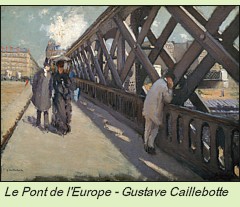
To walk in Paris is to walk through multiple layers of the past, more than 900 years of built history that awaits any stroller. Having lived here for twenty years, I've seen the city change with new roads and bridges, new museums, new rows of apartments. And yet the deep respect that Parisians have developed for what they call their patrimoine, their inheritance, ensures that old buildings are regularly restored and preserved, integrated into the flux of daily life. The look of the city changes subtly, as it has throughout history.
 The biggest transformation in modern times was simply the cleaning of the stone edifices of central Paris, initiated in the 1960's by de Gaulle's Minister of Culture, André Malraux. No change could have been more surprising, or more deeply satisfying. When I was a very young boy living in Paris, I was convinced that all of the buildings were made from the same stone, black as night and so softened by centuries of wood and coal dust that the surface was a felt-like matte whose edges looked as if they would soon crumble. This was the "atmospheric" Paris of all those voluptuous black-and-white photos (what blacks and grays there were on every side), the ponderous Paris of Buffet prints and countless tourist posters.
The biggest transformation in modern times was simply the cleaning of the stone edifices of central Paris, initiated in the 1960's by de Gaulle's Minister of Culture, André Malraux. No change could have been more surprising, or more deeply satisfying. When I was a very young boy living in Paris, I was convinced that all of the buildings were made from the same stone, black as night and so softened by centuries of wood and coal dust that the surface was a felt-like matte whose edges looked as if they would soon crumble. This was the "atmospheric" Paris of all those voluptuous black-and-white photos (what blacks and grays there were on every side), the ponderous Paris of Buffet prints and countless tourist posters.
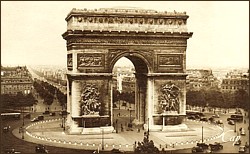
Then the government started to clean the major monuments one by one -- Notre-Dame, the Arc de Triomphe, the Louvre -- and the transformation was shocking, almost troubling in its strange newness. The buildings of Paris weren't black after all, but very nearly . . . white! It took almost two decades of careful cleaning and restoration, but Paris emerged from the process the albino twin of its former self. To appreciate the contrast, buy a vintage postcard aerial view, dating from 1970 or earlier, at one of the bouquiniste stalls along the banks of the Seine, then compare it with the present-day aerial shot: the era of dirt and grime looks like a photographic negative of the light and airy Paris that current tourists will recognize as the "real" Paris.
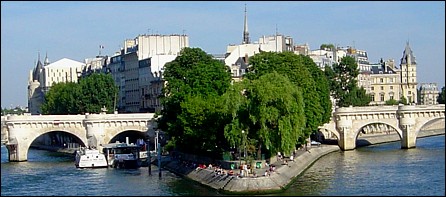
Walking, however, reveals just one facet of the landscape. Recently, in researching a historical novel, I needed to imagine Paris as it would have appeared in the 1820s. The first stop for any such endeavor is the splendid Musée Carnavalet, the Museum of the City of Paris, whose collection documents in elaborate and fascinating detail every step of the city's past. As I consulted paintings, prints, and manuscripts, many of the differences were obvious: in 1825 the Champs-Elysées was already a broad, fashionable avenue, but the Arc de Triomphe did not yet grace its rise; the Eiffel Tower wouldn't appear until 1889; and, of course, Beaubourg, the Pyramid of the Louvre, and the Grande Arche, all sturdy Paris fixtures today, would only appear within the last four decades.
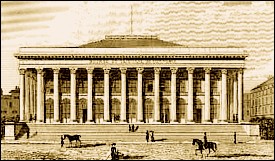 Another clear difference was the absence of cars, though factoring them out mentally also involved imagining the presence of horses . . . lots of horses. As I examined the numberless paintings at Carnavalet, I thought a lot about the look, the sound, and the smell of tens of thousands of horses plying the streets of Paris close to 200 years ago. Merely disposing of their manure -- and Paris was very well organized in this department -- was a Herculean task daily. And, just as in our day, when playboys often drive Porsches and tradesmen more likely use vans, the paintings reveal fancy thoroughbreds ridden solo by dandies, sturdy draft horses pulling huge wagons, and bony nags hitched to battered carts.
Another clear difference was the absence of cars, though factoring them out mentally also involved imagining the presence of horses . . . lots of horses. As I examined the numberless paintings at Carnavalet, I thought a lot about the look, the sound, and the smell of tens of thousands of horses plying the streets of Paris close to 200 years ago. Merely disposing of their manure -- and Paris was very well organized in this department -- was a Herculean task daily. And, just as in our day, when playboys often drive Porsches and tradesmen more likely use vans, the paintings reveal fancy thoroughbreds ridden solo by dandies, sturdy draft horses pulling huge wagons, and bony nags hitched to battered carts.
Perhaps the biggest surprise that comes with seeking the past in the Paris landscape, especially after examining the documentary record, is to realize how little the scale of buildings has changed over the centuries. With two exceptions on the Left Bank (the Tour Montparnasse and the university's Tour Jussieu), no high-rises spoil the illusion in the center of Paris that the modern age has not yet arrived.
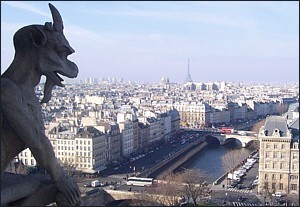 Individual facades, a modern infrastructure, and hordes of cars all tell a different story, but the look and feel of many quartiers -- the Marais and the Latin Quarter are simply the best known examples -- would feel appropriate to a Parisian of the early nineteenth century. This tenuous, heady relationship to the past is often seductive, and yet it can also feel weighty, old-fashioned, and artificial. How long it can prevail in the face of change is anybody's guess.
Individual facades, a modern infrastructure, and hordes of cars all tell a different story, but the look and feel of many quartiers -- the Marais and the Latin Quarter are simply the best known examples -- would feel appropriate to a Parisian of the early nineteenth century. This tenuous, heady relationship to the past is often seductive, and yet it can also feel weighty, old-fashioned, and artificial. How long it can prevail in the face of change is anybody's guess.
Thad Carhart, author of Across the Endless River, is a dual citizen of the United States and Ireland. He lives in Paris with his wife, the photographer Simo Neri, and their two children. For more information, please visit www.thadcarhart.com.
Top of Page
Back to Travel by Novel: Paris
Back to Directory of Articles
©2009 Thad Carhart
Enjoy this page? Please pay it forward. Here's how...
Would you prefer to share this page with others by linking to it?
- Click on the HTML link code below.
- Copy and paste it, adding a note of your own, into your blog, a Web page, forums, a blog comment, your Facebook account, or anywhere that someone would find this page valuable.